Will the last five days of negotiations before the Paris Climate Summit bring us closer to saving the climate?
Media advisory on Bonn Climate Change Conference ADP 2.11
Next week, government representatives will use the last five days of official negotiations in Bonn before the Paris Climate Summit in December (COP21). These talks are crucial as the restructured and slimmed-down draft negotiations text still contains many open points of discussion between countries. In this media advisory, Climate Action Network (CAN) Europe gives an overview of our most important asks for establishing a robust agreement.
In general, a range of key elements in the draft text need to be strengthened (e.g. finance, loss and damage and adaptation), added back in (e.g. the language on decarbonisation as a source of emerging consensus around the long term goal), or clarified (e.g. the concept of scaling up ambition as part of regular reviews). This means that CAN Europe wants the text to be substantially improved on:
1. long term goal
What’s happening:
While the draft text includes references to net zero greenhouse gas emissions and carbon neutrality, it is missing a clear call to phase out global fossil fuel emissions by 2050 and phase in 100% renewable energy by 2050.The latest G7 Summit (Germany, June) and EU Environment Council (Brussels, September) support the decarbonisation of our society. These are very useful first steps. We now need to integrate the need to decarbonise our society by 2050 in the text. Any delay of doing so till after 2050 will bring the need of so-called negative emissions, which will be hard to achieve.
What CAN Europe asks:
The EU needs to advocate for phasing out global emissions and phasing in 100% renewables by 2050. To tackle climate change before it spins out of control, the EU needs to support its allies in developing countries in their pledge for phasing out emissions by the middle of this century. Sending a clear sign to all businesses and investors that the end of fossil fuels is coming and its coming in the next decades, will be an important outcome of the Paris summit.
A brand-new technical briefing by CAN International on the topic: http://climatenetwork.org/publication/can-briefing-paper-tex-suggestions-mitigation-long-term-goal-decarbonization-strategie-0
2. early review mechanism
What’s happening:
More than 120 INDCs have been submitted, of which one INDC represents the 28 EU member states. A first analysis of these pledges shows that even while implemented fully, they would result in global average temperature to increase by at least 2.7°C. Locking in these inadequate INDCs for the next 15 years, would make it impossible to keep temperature rise below 2°C, let alone below 1.5˚C, which is the preferred target of a majority of the world’s countries.
The timeline of this revision will be subject to heated negotiations. The current draft text of the Paris agreement refers to a revision of current INDCs in 2023 and 2024, the draft COP21 Decision text mentions 2018 or 2019, and some countries are even against the concept of this review. The EU’s position for the Paris summit, while supporting five year cycles for the review mechanism, does not specify the start date for the review.
What CAN Europe asks:
The EU needs to advocate for a robust review of current INDCs, by at latest 2018, so as to ensure global emission reduction efforts keep temperature rise well below 2°C.
As it is likely that the INDCs agreed in Paris will be inadequate for staying below 2°C, a pre-2020 revision becomes a necessity. CAN Europe advocates for the revision of the current, inadequate targets to start just after the Paris summit and to be concluded by at latest 2018. This timeline should guarantee that new, improved targets would be in place already in 2020.
In order to ensure a transparant regime, clear accounting rules for all, and commitments that are developed in line with scientific evidence, all countries’ commitments must have the same end date, and every government must negotiate its new target at the same time. If countries intend to move forward at different paces, comparability, as well as the political pressure created by successive negotiating rounds within the UNFCCC process, will be lost. Without synchronised target setting, any review in the Paris protocol will be an ineffective way to increase ambition – as the experience of previous reviews in the UNFCCC have shown.
We call for the EU to support five-year commitment periods as an integral part of the Paris protocol. Short commitment periods that require all countries to step forward with increased targets every five years would be the most effective revision mechanism that can be established at COP 21.
3. post 2020 climate finance
What’s happening:
The current text attempts to capture everything that we need to ensure that climate finance will continue to flow after 2020. However, the means to ensure predictability and consistency are spread across the text, and fail to pin down concrete targets for providing additional public climate finance after 2020. A lot of the options on climate finance are still in brackets in the current draft, meaning they remain open to negotiation. Though the text identifies the need to achieve a balance between support for adaptation and mitigation, like many other sections, much of the concrete language remains in brackets, allowing for the eventual commitment to be vague when it comes to the disbursement of funds.
Because the provision of public climate finance is not spelled out clearly, donor countries can mix in other financial sources – namely private finance – to fill the gaps in financial provisions.
What CAN Europe asks:
The EU needs to advocate for a strong climate finance package that guarantees to continue and increase the provision of new, additional and public climate finance, for both adaptation and mitigation after 2020. We recommend that this could be done by establishing, every five years, collective targets for adaptation and mitigation. The commitment can be re-enforced by requiring contributing countries to announce the planned level of finance that they will provide in the following three years. Such a requirement will allow for both donor and recipient governments to plan for the deployment and eventual use of climate finance.
The text should concretely define that countries should allocate at least 50% of public climate finance to adaptation. In order to guarantee that money is being used well and accounted for properly, the agreement should commit countries to improve their reporting and overall transparency of financial flows. Further on, the agreement text should pin down the commitment to explore and use innovative sources of climate finance, facilitating a process in the years after 2015.



